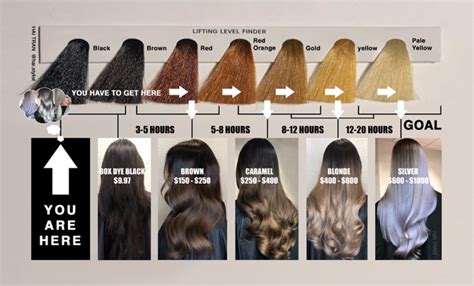Why Dye Hair from Black?
- Express Yourself: Color can be a creative outlet, allowing you to experiment with different looks.
- Cover Gray: Black hair tends to turn gray earlier than other colors, making dye a solution to youthful appearance.
- Enhance Skin Tone: Certain hair colors can complement and enhance your skin’s undertones.
- Style Variety: Dyeing hair opens up options for highlights, balayage, and other color techniques.
The Challenges of Coloring Black Hair
- Strong Pigments: Black hair contains eumelanin, a pigment that’s difficult to remove.
- Damage Risk: Dyeing can damage hair, especially if not done properly.
- Fading: Black dye can fade faster than other colors due to its large molecules.
- Limited Color Options: Some desired hair colors may be difficult or impossible to achieve on black hair.
Professional vs. DIY Dyeing
Professional Dyeing

-
Pros:
- Expertise and proper technique ensure accurate results.
- Uses high-quality products with less damage.
- Offers custom color matching.
-
Cons:
- Can be expensive.
- Appointments may be limited.
DIY Dyeing
-
Pros:
- Convenient and affordable.
- Allows for experimentation.
-
Cons:
- Potential for mistakes and uneven results.
- May use lower-quality products that damage hair.
Dyeing Techniques for Black Hair
Single-Process Color
- Replaces all hair color with a single shade.
- Easiest and most affordable technique.
Double-Process Color
- Involves pre-lightening hair before applying color.
- Provides more color options and vibrancy.
- More damaging than single-process color.
Balayage
- Creates a natural-looking gradient of colors.
- Gentle on hair since it avoids the roots.
Highlights
- Add brighter strands of color to create depth and dimension.
- Can enhance volume and texture.
Best Hair Colors for Black Hair
Warm Shades
- Browns (chestnut, mahogany, cinnamon)
- Reds (copper, auburn, burgundy)
Cool Shades
- Blues (midnight blue, navy)
- Purples (plum, violet)
Neutral Shades
- Gray (ash, platinum)
- Beige (mushroom, sand)
Hair Care After Dyeing
Moisturizing Treatment
- Replenish moisture lost during dyeing.
- Use hair masks, deep conditioners, and leave-in products.
Color-Protecting Shampoo and Conditioner
- Formulated to prevent fading and extend color life.
- Look for products with UV protection.
Heat Protection
- Avoid excessive heat styling, which can damage colored hair.
- Use heat protectants and reduce the temperature of styling tools.
FAQs
-
Can I dye my black hair blonde?
– Yes, but it requires double-processing and can be damaging. -
How often should I re-dye my hair?
– Every 6-8 weeks to touch up roots and refresh color. -
Will dyeing my hair damage it?
– Any chemical process can damage hair, but proper care and professional styling can minimize it. -
What are the best products for color-treated hair?
– Color-safe shampoos, conditioners, and masks designed for protecting and nourishing colored hair. -
How can I prevent color fading?
– Wash hair less frequently, use cold water, and protect from UV rays. -
What should I do if I dye my hair and don’t like it?
– Consult a professional stylist to explore options for color correction or waiting for the color to fade.
Coloring black hair can be a transformative experience, but it’s important to approach it with care and consideration. By understanding the challenges, choosing the right technique, and following proper aftercare, you can achieve beautiful, healthy hair in any color you desire.
